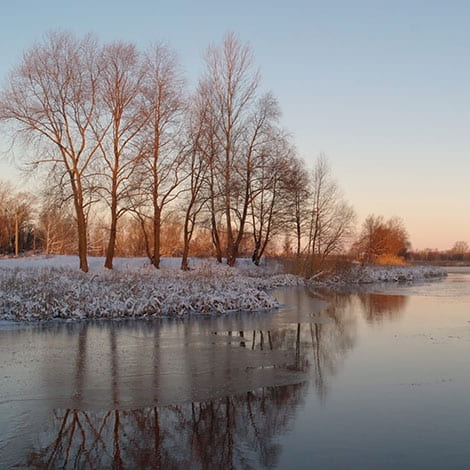Asked By: Allen of Marcola, OR
A: Unfortunately, it's tough to provide a definitive answer. The growth pattern of common aquatic weeds and algae depends on your location. Weed growth in a Florida pond is much more aggressive than in a Minnesota pond!
Different aquatic nuisance species generally pop up at different times of the year, depending on temperature and sunlight exposure. Perennial weeds continue slowly growing throughout the winter, including invasive pond plants that can swiftly takeover in spring. The following are four of the most common invasive aquatic plants to watch out for in your pond or lake.
Eurasian Watermilfoil (Myriophyllum spicatum)
Milfoil are submerged aquatic weeds with feathery leaves that emerge in whorls around long, slender stems. They are sometimes mistaken for coontail, which has spiny, needle-like leaves resembling a pine tree. Eurasian watermilfoil is a highly invasive aquatic plant in North America that invades stagnant and slow-moving waterways.
Eurasian watermilfoil is challenging to control due in part to its ability to reproduce via fragmentation. If any piece of the plant breaks off, it will sprout roots and rapidly grow into a new plant. This makes mechanical control methods largely ineffective unless every single scrap of the plant is removed.
Curly-Leaf Pondweed (Potamogeton crispus)
Another nuisance pondweed in North American ponds and lakes is curly-leaf pondweed. These submerged plants feature waxy, wavy leaves arranged alternately along flattened stems. The color ranges from bright green in spring to dull brown in fall. It is common to see these invasive weeds sprout up in eutrophic (nutrient-polluted) waters, especially in the Great Lakes region.
Curly pondweed is rhizomatous, reproducing through turion buds that germinate in fall and then overwinter. These aggressive plants outcompete native vegetation in early spring and crowd the water, blocking sunlight and further inhibiting the growth of other pond plants.
Hydrilla (Hydrilla verticillata)
Also known as waterthyme, Hydrilla is a genus of aquatic weeds that is sometimes divided into multiple species. These perennial plants have long, thin stems whorled with tiny, serrated leaves. Hydrilla can be differentiated from similar-looking native Elodea by the number of leaves per whorl—Hydrilla has four to eight, while Elodea has three.
Like many aquatic nuisance plants, Hydrilla is difficult to eradicate due to how the plant reproduces. These stubborn weeds pull out all the stops, spreading via fragmentation, turions, rhizomes, and seeds.
Common Reed (Phragmites australis)
Phragmites—colloquially called common reeds—are among the most prevalent invasive pond grasses distributed globally. They can grow up to 20 feet tall in fertile regions with hot summers and mild winters. Reeds and cattails often crowd marginal areas of ponds and lakes, impeding fishing and other recreation.
Phragmites are flowering grasses that can reproduce via seeds, but they often spread even more rapidly by placing runners from underground rhizomes. This nuisance pond weed is so prolific and stubborn that people frequently turn to multiple controlled burns to eradicate established reed beds.
Aquatic Nuisance Plant Control
You can help combat the spread of invasive aquatic plants that threaten North American waterways by reporting suspected occurrences to the appropriate authorities. If you detect a nuisance aquatic species in your pond or lake, we have treatment and control options available.
Mechanical aquatic weed removal tools are beneficial in eliminating minor infestations and controlling larger outbreaks that need further chemical action. When cutting and skimming aren’t enough, aquatic herbicides help kill existing weeds and prevent future growth from occurring. Biological remediation methods include adding grass carp, which dine on many invasive pond weeds.
Trouble surfaces when water temperatures drop too low for herbicides to be effective, but weeds continue to grow. When this happens, you can turn to pond dye, an effective year-round treatment that shades and beautifies the water regardless of the time of year.
Pond Weed Control & Prevention Advice
Do you need help battling invasive aquatic weeds in your pond? Our helpful pond experts are here to help answer your questions! Call us at 866-POND-HELP or contact us online today for prompt and friendly advice.
Read more about pond weed control and prevention in the following helpful guides:
Identify Your Weeds
How to Treat Pond Weeds
Use Only Approved Chemicals for Ponds
To Treat or Not to Treat
Aquatic Weed Control and Treatment
Last Updated: November 1, 2024

